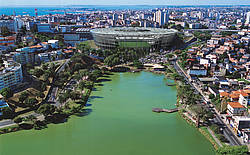Münster, 16 June 2014 – For the majority of the Brazilian World Cup stadiums, ArmaFlex was the material of choice when it came to insulating refrigeration and air-conditioning installations. The elastomeric insulation material from the market leader Armacell was used in eight out of twelve venues.
Like many sports stadiums and multi-purpose arenas throughout the world, the new World Cup stadiums in Brazil relied primarily on products from Armacell when insulating refrigeration installations. In service and administration facilities, the highly flexible insulation material protects the chilled-water pipes and air ducts of the air-conditioning systems against condensation and energy losses. Whilst extensive renovations equipped six existing arenas for the championship, the six other stadiums were built from scratch. The sporting venues in which Armacell products were installed include the Estádio Nacional in Brasília, the second largest World Cup stadium with a capacity of over 70,000 seats, the magnificent Estádio Mineirão in Belo Horizonte and the Arena da Amazônia in Manaus, the most controversial and - from an architectural point of view - most unusual stadium of this World Cup. All in all, 50,000 m of insulation tubes and 15,000 m2 of sheet material were installed in eight World Cup stadiums and the Arena Grêmio in Porto Alegre, which was constructed at the same time.
Armacell has been selling its products successfully on the Latin American market since the mid nineties and in 2003 the company opened its own production facilities in Brazil. At the Armacell plant in Pindamonhangaba (near São Paulo) technical insulation materials for the Mercosur region are manufactured.
Products
16 June 2014

